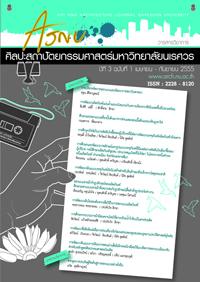การศึกษาและออกแบบเครื่องปั้นดินเผาจากส่วนผสมของเนื้อดินและผงหินภูเขาไฟ
Main Article Content
Abstract
การวิจัยครั้งนี้มีวัตถุประสงค์เพื่อ 1.) ศึกษาอัตราส่วนผสมและสมบัติทางกายภาพของเนื้อดินจากผงหินภูเขาไฟกระโดง ที่เหมาะสมในการผลิตเครื่องปั้นดินเผา 2.) ออกแบบผลิตภัณฑ์เครื่องปั้นดินเผาบุรีรัมย์ โดยใช้เนื้อดินจากผงหินภูเขาไฟกระโดง ที่ได้จากการทดลอง 3.) ประเมินความพึงพอใจ ผู้จำหน่าย และผู้บริโภค ที่มีต่อรูปแบบผลิตภัณฑ์เครื่องปั้นดินเผาบุรีรัมย์ โดยใช้เนื้อดินจากผงหินภูเขาไฟกระโดง ที่ได้ออกแบบแล้ว โดยมีวิธีดำเนินการวิจัย ขั้นตอนที่ 1 คือ การศึกษาอัตราส่วนผสมและสมบัติทางกายภาพ ของเนื้อดินจากผงหินภูเขาไฟกระโดง อัตราส่วนผสมที่ใช้ในการวิจัยได้อ่านค่าวัตถุดิบ 3 ชนิด คือ ผงหินภูเขาไฟ ดินดำ และดินขาว ที่เหมาะสมสำหรับการขึ้นรูปแบบหล่อน้ำดิน ขั้นตอนที่ 2 คือ ออกแบบผลิตภัณฑ์ที่เป็นเอกลักษณ์ของเครื่องปั้นดินเผาบุรีรัมย์ โดยใช้เนื้อดินจากผงหินภูเขาไฟกระโดง ที่ได้จากการทดลอง ขั้นตอนที่ 3 คือ การประเมินความพึงพอใจของผู้จำหน่าย ผู้บริโภค ทั้งหมด 5 ด้านคือ ด้านลักษณะเฉพาะถิ่น ด้านวัตถุประสงค์ในการผลิต ด้านกรรมวิธีในการผลิต ด้านขนาดสัดส่วน และด้านความสวยงาม
ผลการทดลอง โดยใช้ตารางสามเหลี่ยมด้านเท่า จำนวน 36 จุด ได้สูตรอัตราส่วนผสม จุดที่ 8 มีสมบัติทางกายภาพที่มีความเหมาะสมในการขึ้นรูปแบบหล่อน้ำดินและได้ตามมาตรฐานของเนื้อดินสโตนแวร์ดีที่สุด และจากปริมาณอัตราส่วนผสมในเนื้อดิน ที่มีปริมาณวัตถุดิบในท้องถิ่น คือ ผงหินภูเขาไฟ ถึงร้อยละ 50 ทำให้สามารถลดต้นทุนในการผลิตเครื่องปั้นดินเผาได้มาก และได้นำมาออกแบบผลิตภัณฑ์เครื่องปั้นดินเผาบุรีรัมย์ โดยใช้เนื้อดินจากผงหินภูเขาไฟกระโดง ที่ได้จากการทดลอง จำนวน 3 รูปแบบ โดยใช้รูปแบบและลวดลายของเคลือบดินเผาบุรีรัมย์ ใช้กรอบแนวคิดด้านการออกแบบ จำนวน 5 ด้าน ในการประเมินผลโดยผู้เชี่ยวชาญทั้ง 5 ท่าน พบว่า โดยภาพรวมรูปแบบที่ 3 มีความเหมาะสมมากที่สุด และการประเมินความพึงพอใจของ ผู้จำหน่าย และผู้บริโภค ที่มีต่อรูปแบบผลิตภัณฑ์เครื่องปั้นดินเผาบุรีรัมย์ โดยใช้เนื้อดินจากผงหินภูเขาไฟกระโดง ที่ได้ออกแบบแล้ว พบว่า โดยภาพรวมมีความพึงพอใจอยู่ในระดับมากเหมือนกัน
Study And Ceramics Design From Composition Of Clay Bodies And Basalt Stone
The objectives of this study were 1) study the most appropriated compositions and physical qualifications of basalt stone clay body from Kradong hill for ceramics products, 2) design Buriram ceramics products using experimented basalt stone clay body from Kradong hill, and 3) evaluate the satisfactions of distributors and customers with the ceramics product design. The research methodology can be divided into three steps. First, the researcher studied the compositions and physical qualifications of basalt stone clay body from Kradong hill. The study focused on the three compositions for molding the casting slip which were basalt stone, ball clay, and kaolin. Then, the researcher designed the Buriram pattern ceramics products using the experimented basalt stone clay body. Finally, the satisfactions of distributors and customers for the product design were evaluated in the following aspects: local identity, production objective, production process, size, and beauty.
The 36-points triaxial blend was used to find out the most appropriated ingredient compositions. The eighth point was finally chosen because the physical qualification was most appropriated to mould the casting slip which would provide the standard stoneware products. At this composition, the Kradong hill basalt stone was used at 50% ratio of the clay body which showed the reduction of production cost. Three patterns of ceramics products were then designed using the experimented basalt stone clay body. Buriram ceramics patterns and designs were used along with the five concept designs which were evaluated by five specialists. The third pattern was considered most appropriated for ceramics products. Moreover, the study showed that the distributors and customers were satisfied with the product design at a high level.


